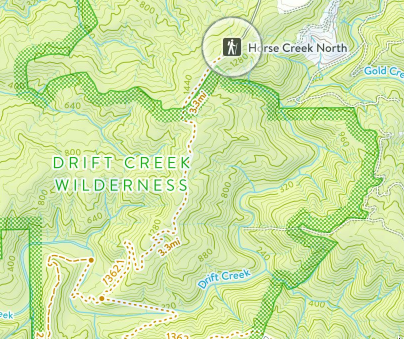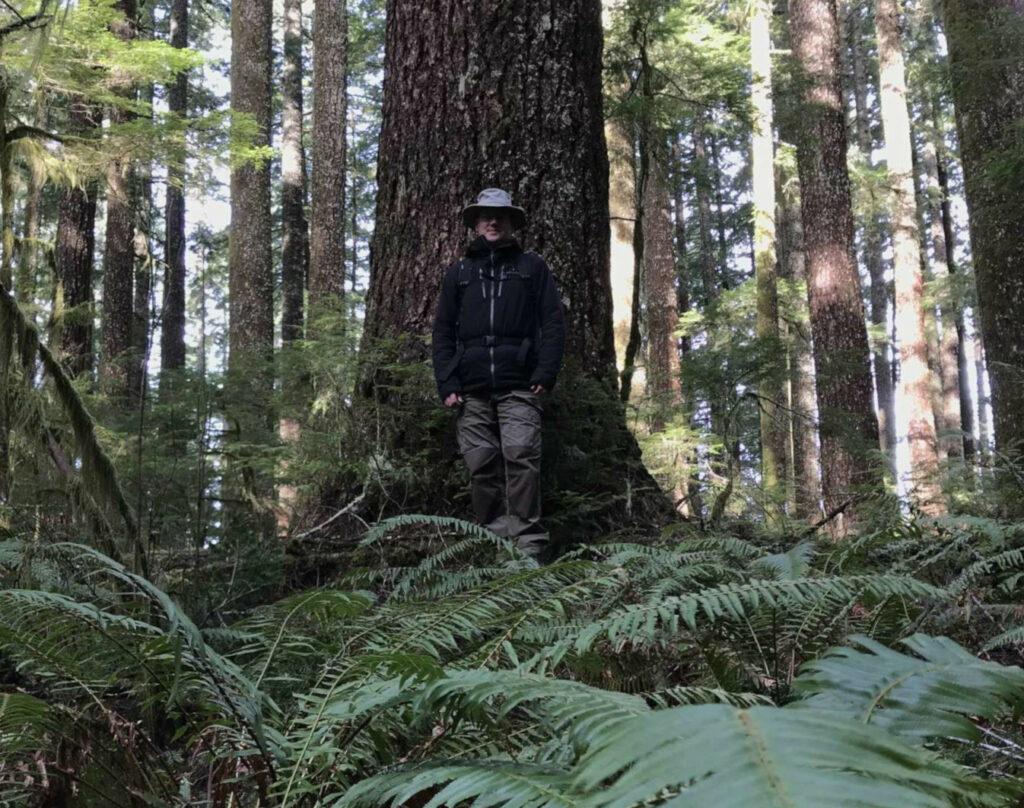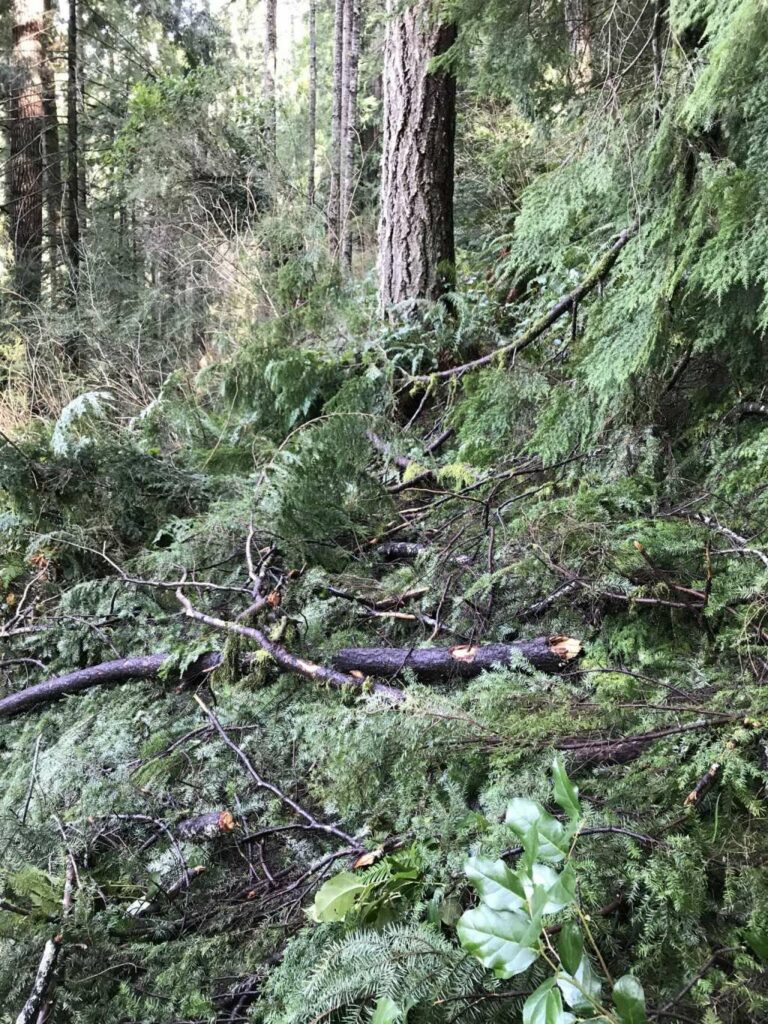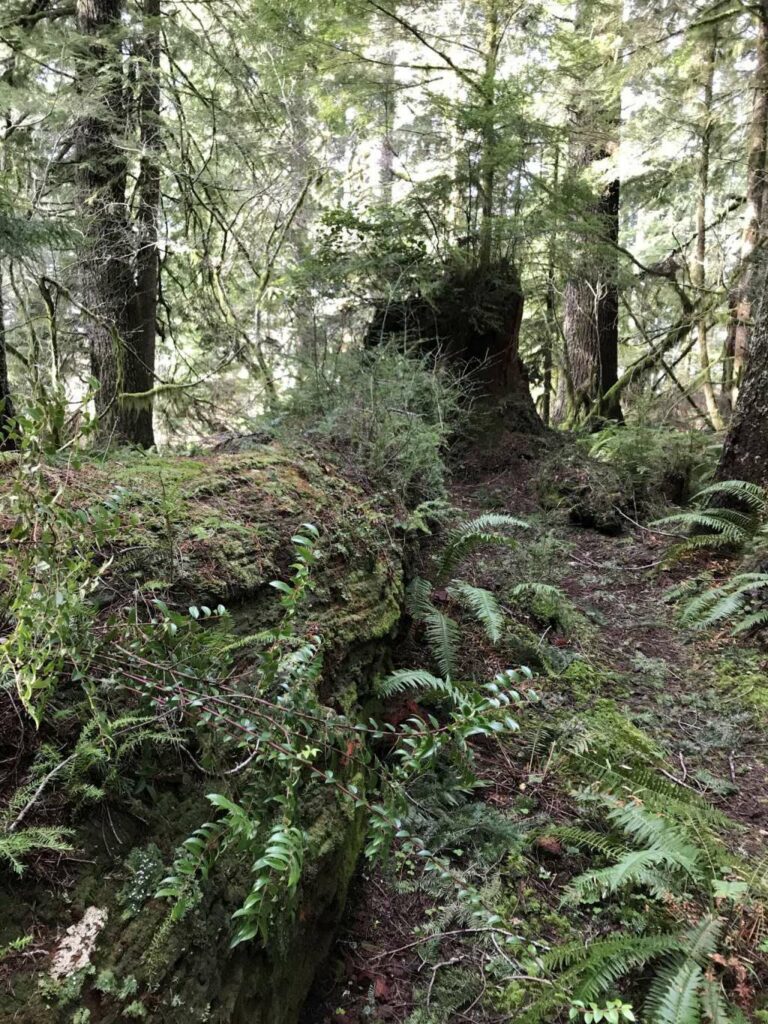
OK, well maybe just a little. This week's hike was to Horse Creek North on the Oregon coast. Since it was just north of Waldport I took Hwy 34 down from Corvallis then turned north on 101. At Ona Beach you turn east into the hills, the paved road quickly transitioning to one lane along Beaver Creek then to one-lane logging roads gaining altitude with each curve. The road just ends, and there you leave the car to continue on foot along the ridge. After half a mile you leave the old logging road and turn left into the forest proper.
Within steps you are in a primordial forest where the trail squeezes between giant trunks. Where verdant moss covers all the open horizontal surfaces and creeping up the trunks as if wanting to know what it is like up in the vast heights. These are the largest Western Hemlocks I've ever seen, some over six feet in diameter. I'm used to the look of the bark on up to 2-1/2ft diameter trees and above that they lose the striation and get a little "chunked up" looking. Nothing as extreme as the Douglas firs though with their awesomely thick alligator plates.

Big Western Hemlock
I take a few moments to savor the scene. An intense silence envelopes me as I notice that there isn't even a breath of wind rustling the tree tops 150ft above me, only the occasional "peep, peep" of an unknown under story bird. The forest didn't have a "piney" smell, just fresh and sparkling. Musing on this I connected the dots of my knowledge. Warmth will make aromatics disperse more than cold. The coast range here gets over 120" of rainfall outside of the summer months. The warm dry summer forests have a wonderful, intense piney smell. It has been shown that forests emit aerosols into the atmosphere that become the nuclei for raindrop formation. Maybe, in addition to the lower temps, lower respiration and shorter daylight, the trees aren't putting out that piney smell because they've got all the rain they need at this time of year.

Is there a trail through there?
As I continue on down the trail I become keenly aware of all the small, and not so small, branches that litter the forest floor. The winter storms take back some of the progress of last season's growth and I'm sure the branchlets aren't missed by these giants. Anyways, they will just decompose and create the soil that the trees will get sustenance from in the future. What's even a 100 year decomposition when you can live to over 1200 years? I pick up the occasional "tripper" branch and dodge countless others. I pause because I thought I hear something. There it is again, the raspy call of a raven. This lifts my heart. I've come to think of the raven as one of my personal totems. I encounter them more now than ever and they are always a welcome sight or sound. This one, however, is somewhere in the tree tops and lucky for me the trail heads in its direction. I keep getting closer, trying to pinpoint which giant it is in. The trail drops off the ridge slightly and goes past where I think the raven is. Of course, it is in one of the tallest trees on the high point of the ridge. Even if I had my binoculars, I doubt I would have seen it. I bid it a good day and carry on.
After a gentle descent the trail winds southeast onto a smaller ridge before turning back south and traversing the main ridge again. Descending, always descending. A few switchbacks and we've gone around to a more west facing aspect. Then the real descent starts, as if the trail had been playing with me and now gives me both barrels. The broken branches and tree fall increase. Makes sense I think, considering the winter storms come in from the south to southwest. At one point I have to go both over AND under a fall. The hillside is steep and going around any of these would be perilous. Short, tight switchbacks alternate with long jogs to one direction or another. I keep peering into the trees below trying to see if there is a valley bottom. I can hear the creek now, but it sounds distant, miles off even. I continue, then all of a sudden the creek is louder and the slope is leveling out. I step out into an open mossy area with a fire ring and space for a couple tents, the lower tree limbs drenched in vibrant moss. Drift creek is just beyond, carving the valley ever deeper. I follow little trails this way and that to find access to the creek, but the bank is too steep for me to want to risk a scramble. A few pictures will have to suffice.

Nurse Log
It is now mid-afternoon and the days are still not long at this time of year so I take off another layer and start the uphill trek. I remind myself, "slow and steady", and commit. I rationalize that I might be able to make it back in the same time since I won't be stopping to gawk at every above average tree. We humans are great rationalizers aren't we? It isn't a race and my only clock is the setting sun, and I've got a headlamp besides. I pass the old trunk that has toppled with its wig of Evergreen Huckleberry. After I conquered the "west face" I keep looking for the 30ft stump I named "Big Red" on the way down which signified I was done with the main ascent. It turns out there many that I could have named big red. I recognized the SE ridge and then got back onto the main ridge. All of a sudden I stop and look left. My subconscious had been paying attention. Right off the trail 100m there's my guess as to the tree where the raven was earlier. I haven't heard from it in hours, but I call to it anyway. A crow is easy to imitate, but the gutteral rasp of a raven? Good thing there was no one around to suffer my poor attempt. I did hear it once more, later, off to the east down in the watershed attending to raven business.
My steps were light as I went along the ridge of giants. The patchy sunlight was hitting the ferns and tree boles with the radiance of the approaching golden hour. My thoughts turned to this magnificent forest and how lucky these trees were in a designated wilderness, safe from development and saw. They aren't safe from the pressures of climate change though. For the Oregon coast range, the jet stream is king. We owe our lush wet winters to this giant river of moist, ocean air pointing right at us, just as we owe that stretch of blue sky weather in summer to its moving north. One of science's more recent revelations has been the discovery of the biotic pump that is created by forests transpiring water into the air, along with those aerosols, to be carried further inland and increase rainfall. The forests inland then provide the same action creating a linked circulation. With this knowledge, the people living in the Willamette Valley, or Central Oregon, or even farther east, should have a keen interest in protecting the forests in the coast range and the Cascades. I encourage them to visit these majestic forests and experience the awe.
Inspiration
Clearing Forests May Transform Local—and Global—Climate
https://www.scientificamerican.com/article/clearing-forests-may-transform-local-and-global-climate/
Trees in the Amazon make their own rain
https://www.sciencemag.org/news/2017/08/trees-amazon-make-their-own-rain